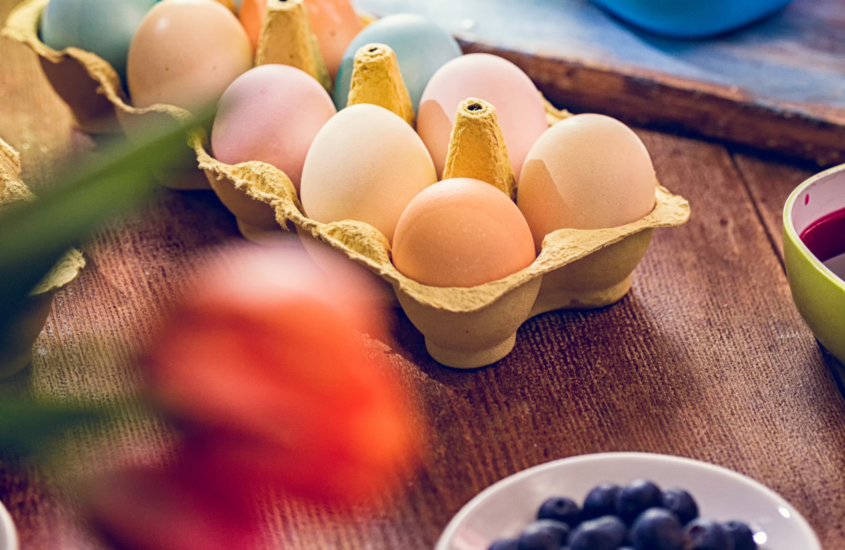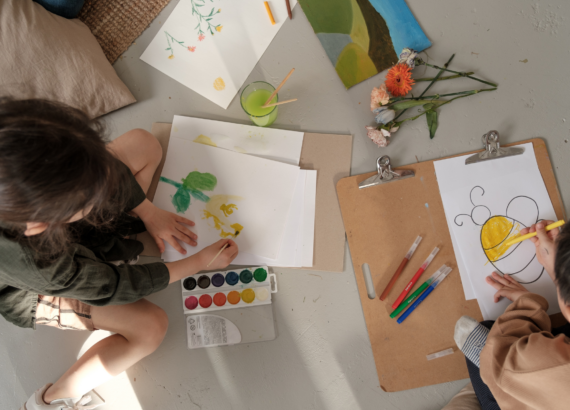“Egg-citing” Alternatives: Dye Your Easter Eggs Naturally
AmericanMom Team |
Easter egg coloring is a joyful tradition that brings joy to families, especially with young children. Sadly, many traditional food coloring products contain synthetic chemicals and artificial dyes that can be harmful to both health and the environment. If you’re looking for a healthier, non-toxic way to color your Easter eggs, look no further! We’ve gathered some simple and natural alternatives that not only create beautiful, vibrant colors but are also safe and sustainable.
1. Beetroot – A Red/Pink Hue
Beets aren’t just for salads—they make a fantastic natural dye! To make beet dye, start by boiling a few beets in water until the water turns a deep pinkish-red color. Strain out the beet chunks, and you’ll be left with a beautiful dye that will color your eggs a rich, vibrant red or pink.
How to Use:
- Boil the beets and let the water cool.
- Soak your eggs in the beet juice for 15-30 minutes, depending on the shade you want.
- For deeper colors, let the eggs soak longer or add a tablespoon of vinegar to intensify the hue.
2. Turmeric – Bright Yellow and Golden Shades
Turmeric is a fantastic natural dye that creates a beautiful golden yellow color. Plus, it’s an easy way to add some sunshine to your Easter festivities!
How to Use:
- Mix 2 tablespoons of turmeric with 1 cup of water and bring it to a boil.
- Add 1 tablespoon of vinegar to help the dye adhere to the eggs.
- Once the mixture has cooled, dip your hard-boiled eggs into the turmeric solution. The longer you leave the eggs in, the more vibrant the yellow will become.
3. Red Cabbage – Blue and Purple Tones
Red cabbage may surprise you with its ability to produce vibrant blue and purple colors when boiled. This all-natural dye gives eggs a unique and eye-catching hue.
How to Use:
- Chop the red cabbage into small pieces and boil in 2 cups of water for 10-15 minutes.
- Strain the cabbage out and let the dye cool.
- Add 1 tablespoon of vinegar to the dye to help set the color.
- Soak your eggs in the dye for 30 minutes to several hours, depending on how deep you want the color to be.
4. Spinach – A Soft Green Shade
For a subtle, pastel green color, spinach is your go-to natural dye. This vibrant green can add a refreshing touch to your Easter eggs, and it’s completely safe for both children and the planet.
How to Use:
- Boil a handful of spinach leaves in water for 10 minutes until the water turns a bright green.
- Strain out the spinach and allow the dye to cool.
- Add a tablespoon of vinegar to the dye.
- Dip your eggs into the spinach dye and leave them in for 30 minutes to an hour for a gentle green tint.
5. Coffee or Tea – A Vintage Brown or Tan
For a lovely vintage or rustic look, coffee or tea makes an excellent dye. The rich, earthy tones will give your eggs a warm brown or tan color, perfect for a more natural Easter palette.
How to Use:
- Brew a strong cup of coffee or tea, then let it cool.
- Add a tablespoon of vinegar to help the dye adhere to the eggs.
- Let your eggs soak for 30 minutes or longer, depending on the intensity of color you want.
6. Onion Skins – Orange and Red Shades
Onion skins are an “eggcellent” natural dye source that creates beautiful orange, red, or even golden hues. The skins of both red and yellow onions work well for dyeing eggs, and you can create a beautiful marbled effect using this method.
How to Use:
- Collect onion skins (red or yellow) and boil them in water for about 10 minutes.
- Strain the skins and add 1 tablespoon of vinegar to the dye.
- Soak your eggs for about 30 minutes to get a rich, rustic orange color.
7. Avocado Pits and Skins – Soft, Pinkish Tones
Avocados don’t just provide a tasty snack—they also make a beautiful natural dye. The pits and skins of avocados create a soft, light pink or peach color that’s perfect for a pastel Easter palette.
How to Use:
- Simmer the avocado pits and skins in water for 10 minutes until the water takes on a reddish hue.
- Strain out the avocado parts and add 1 tablespoon of vinegar.
- Let your eggs soak for about 30 minutes for a delicate, pinkish tone.
8. Blackberries – Deep Purple and Blue Shades
Blackberries provide a rich, deep purple color that makes for stunning Easter eggs. This dye works best for those who want darker, more dramatic tones on their eggs.
How to Use:
- Mash a handful of blackberries and simmer them in water for 10-15 minutes.
- Strain the mixture to remove the pulp and seeds.
- Let the dye cool, then add a tablespoon of vinegar.
- Soak your eggs for 30 minutes to 1 hour, depending on the intensity of the color you prefer.
Tips for Natural Egg Dyeing:
- Vinegar: Adding vinegar to the dye helps the color adhere to the eggs and intensifies the hue. A tablespoon per cup of dye usually does the trick.
- Longer Soaks = Deeper Colors: The longer you leave your eggs in the dye, the deeper the color will become. If you’re looking for pastel shades, a quick soak will do; for more intense hues, leave the eggs in for a few hours or overnight.
- Creative Effects: For a fun and unique look, consider wrapping your eggs in natural materials like onion skins, leaves, or fabric before dyeing them. The natural imprints will create interesting patterns on the eggs.
With these natural dyes, you can create beautiful, vibrant eggs without worrying about harmful chemicals. Whether you prefer soft pastels or bold, rich colors, the possibilities are endless. This Easter, embrace the beauty of nature and enjoy a healthier, more sustainable holiday tradition with your loved ones!






